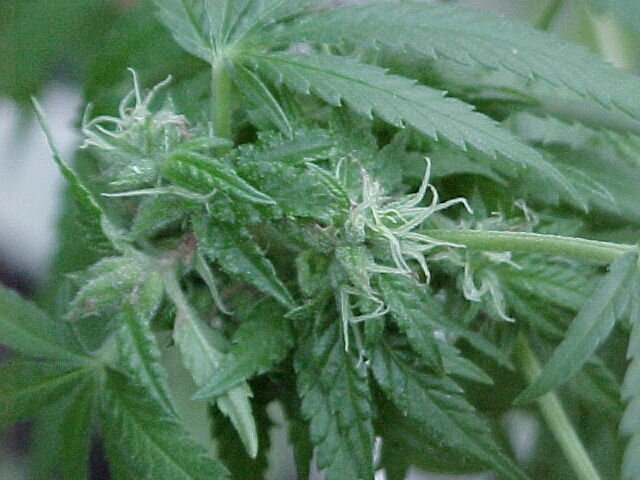max316420
Well-Known Member
Marijuana Plant Abuse
Marijuana plant abuse disorders, deficiencies, problems with photographs and descriptions.
Look closely, and you'll see the brown leaf edges that are indicative of heat stress. This damage looks alot like nutrient burn, except it occurs only at the tops of the plants closest to the lamps. There's only one cure for this...get the heat away from the plants, either by moving the lamps or moving the plants.

Nutrient Solution Burn
There's a good chance that this bud was subjected to nutrient solution burn. These symptoms are seen when the EC concentration of hydroponic solutions is too high. These symptoms also appear when strong nutrient solution is splashed onto the leaves under hot HID lamps, causing the leaves to burn under the solution.
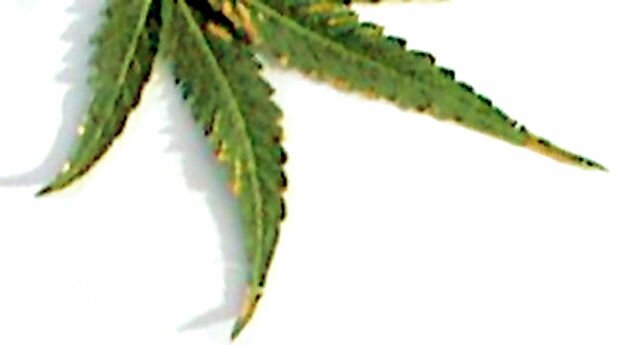
Many hydroponic gardeners see this problem. It's the beginning of nutriet burn. It indicates that the plants have all the nutrients they can possibly use, and there's a slight excess. Back off the concentration of the nutrient solution just a touch, and the problem should disappear. Note that if the plants never get any worse than this here, then the plants are probably just fine.
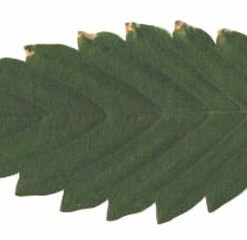
Figure 4 is definitely an over-fert problem. The high level of nutrients accumulates in the leaves and causes them to dry out and burn up as shown here. You must flush with clear, clean water immediately to allow the roots to recover, and prevent further damage. The find the cause of the high nutrient levels.
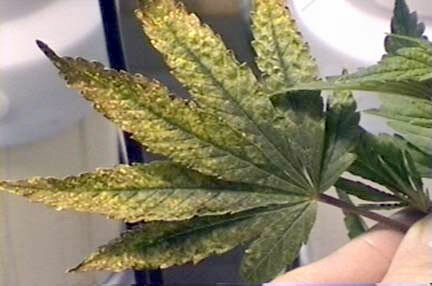
Over Watering
The plants in Figure 1 were on a continous drip system, where nutrient solution is constantly being pumped into the medium. This tends to keep the entire root system completely saturated. A better way would be to periodically feed the plants, say for 1/2 hour every 2-3 hours. This would give the roots a chance to get needed air to them, and prevent root rot and other problems.
Don't be throw off by the fact that the plants in Figure 2 are sitting in still water, this is actually an H2O2 solution used to try and correct the problem. Adding an airstone to the tub would also help add O2 to the solution.
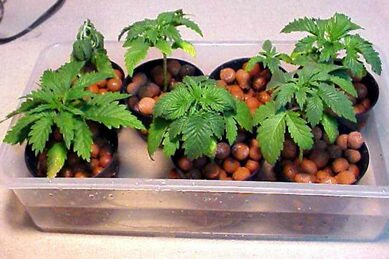
pH Fluctuation
Both of these leaves in figure 3 and figure 4 are from the same plant. It could be over fertilization, but more likely it is due to the pH being off. Too high or too low a pH can lock up nutrients in the form of undisolvable salts and compounds, some of which are actually toxic to the plants. What then happens is the grower then tries to supplement the plants diet by adding more fertilizers, throwing off the pH even more and locking up even more nutrients. This type of problem is seen more often in soil mixes, where inconsistent mixing of the medium's components leads to "hot" spots.
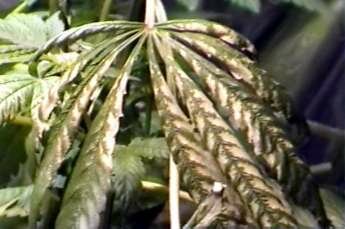
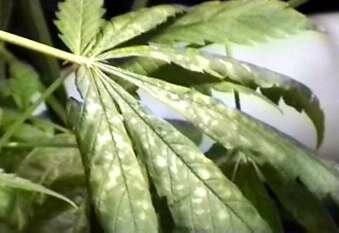
Ozone damage
Ozone damage typically found near the generator. Although a rare problem, symptoms generally appear as a Mg deficiency, but the symptoms are localized to immediately around the generator.
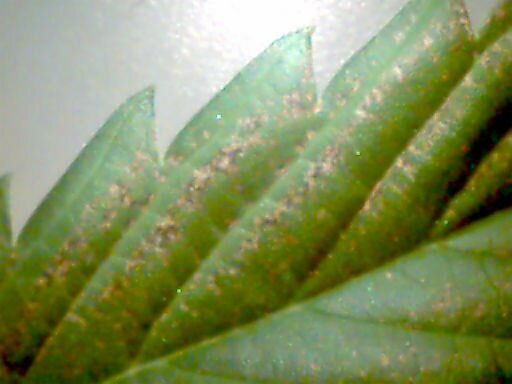
NUTRIENT PROBLEMS
Root stunting
Root stunting is characteristic of calcium deficiency, acidity, aluminum toxicity, and copper toxicity. Some species may also show it when boron deficient. The shortened roots become thickened, the laterals become stubby, peg-like, and the whole system often discolours, brown or grey.
Symptoms localized at shoot growing points.
New shoots unopened; young leaves distorted; dead leaf tips; pale green plant copper deficiency
New shoots withered or dead; petiole or stem collapse; shoots stunted; green plant calcium deficiency
Young leaves pale green or yellow; rosetting or dead tip; dieback; dark green plant boron deficiency
top of page
MOBILE ELEMENTS
Mobile elements are more likely to exhibit visual deficiencies in the older leaves, because during demand these elements will be exported to the new growth.
Nitrogen (N)
Nitrate - Ammonium is found in both inorganic and organic forms in the plant, and combines with carbon, hydrogen, oxygen and sometimes sulfur to form amino acids, amino enzymes, nucleic acids, chlorophyll, alkaloids, and purine bases. Nitrogen rates high as molecular weight proteins in plant tissue.
Plants need lots of N during vegging, but it's easy to overdo it. Added too much? Flush the soil with plain water. Soluble nitrogen (especially nitrate) is the form that's the most quickly available to the roots, while insoluble N (like urea) first needs to be broken down by microbes in the soil before the roots can absorb it. Avoid excessive ammonium nitrogen, which can interfere with other nutrients.
Too much N delays flowering. Plants should be allowed to become N-deficient late in flowering for best flavor.
Nitrogen DeficienciesPlants will exhibit lack of vigor, slow growth and will be weak and stunted. Quality and yield will be significantly reduced. Older leaves become yellow (chlorotic) from lack of chlorophyll. Deficient plants will exhibit uniform light green to yellow on older leaves, these leaves may die and drop. Leaf margins will not curled up noticeably. Chlorosis will eventually spread throughout the plant. Stems, petioles and lower leaf surfaces may turn purple.
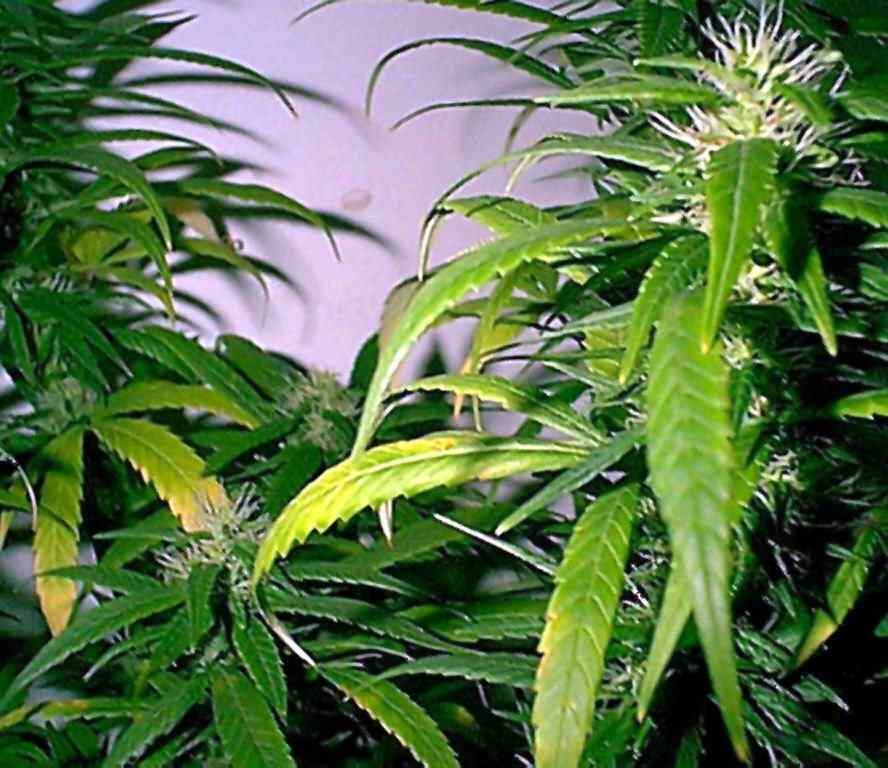
As seen in figure 10 consumption of nitrogen (N) from the fan leaves during the final phase of flowing is 100% normal.
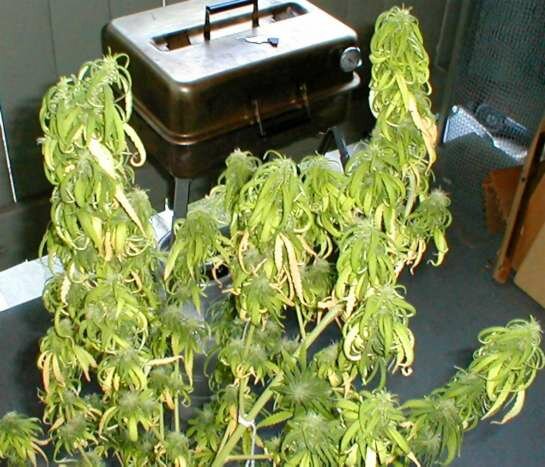
Nitrogen Toxicity
Leaves are often dark green and in the early stages abundant with foliage. If excess is severe, leaves will dry and begin to fall off. Root system will remain under developed or deteriorate after time. Fruit and flower set will be inhibited or deformed.
With breakdown of vascular tissue restricting water uptake. Stress resistance is drastically diminished.
Phosphorus
Phosphorus is a component of certain enzymes and proteins, adenosine triphosphate (ATP), ribonucleic acids (RNA), deoxyribonucleic acids (DNA) and phytin. ATP is involved in various energy transfer reactions, and RNA and DNA are components of genetic information.
Phosphorus (P) deficiency
Figure 11 is severe phosphorus (P) deficiency during flowering. Fan leaves are dark green or red/purple, and may turn yellow. Leaves may curl under, go brown and die. Small-formed buds are another main symptom.
Phosphorus deficiencies exhibit slow growing, weak and stunted plants with dark green or purple pigmentation in older leaves and stems.
Some deficiency during flowering is normal, but too much shouldn't be tolerated. Red petioles and stems are a normal, genetic characteristic for many varieties, plus it can also be a co-symptom of N, K, and Mg-deficiencies, so red stems are not a foolproof sign of P-deficiency. Too much P can lead to iron deficiency.
Purpling: accumulation of anthocyanin pigments; causes an overall dark green color with a purple, red, or blue tint, and is the common sign of phosphate deficiency. Some plant species and varieties respond to phosphate deficiency by yellowing instead of purpling. Purpling is natural to some healthy ornamentals.
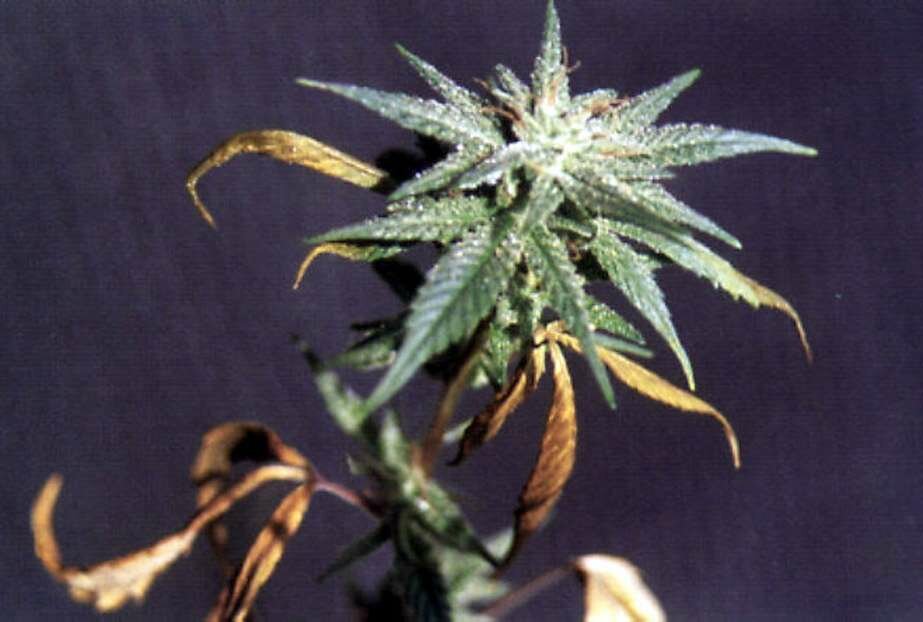
Figure 12 shows Phosphorus (P) deficiency during vegatative growth. Many people mistaken this for a fungus, but look for the damage to occur near the end of leave, and leaves the color dull greyish with a very brittle texture.
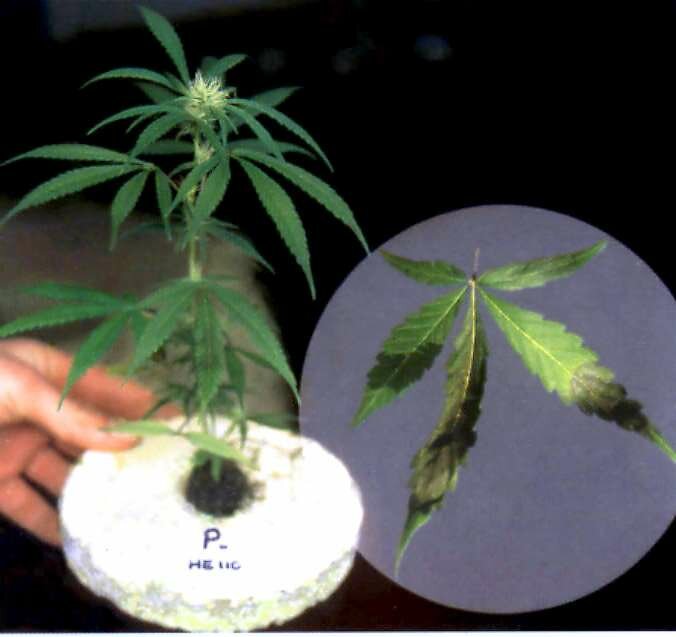
Phosphorus (P) Toxicity
This condition is rare and usually buffered by pH limitations. Excess phosphorus can interfere with the availability and stability of copper and zinc.
Potassium (K)
Potassium is involved in maintaining the water status of the plant and the tugor pressure of it's cells and the opening and closing of the stomata. Potassium is required in the accumulation and translocation of carbohydrates. Lack of potassium will reduce yield and quality.
Potassium deficiency (K).
Older leaves are initially chlorotic but soon develop dark necrotic lesions (dead tissue). First apparent on the tips and margins of the leaves. Stem and branches may become weak and easily broken, the plant may also stretch. The plant will become susceptible to disease and toxicity. In addition to appearing to look like iron deficiency, the tips of the leaves curl and the edges burn and die.
Potassium - Too much sodium (Na) displaces K, causing a K deficiency. Sources of high salinity are: baking soda (sodium bicarbonate "pH-up"), too much manure, and the use of water-softening filters (which should not be used). If the problem is Na, flush the soil. K can get locked up from too much Ca or ammonium nitrogen, and possibly cold weather.
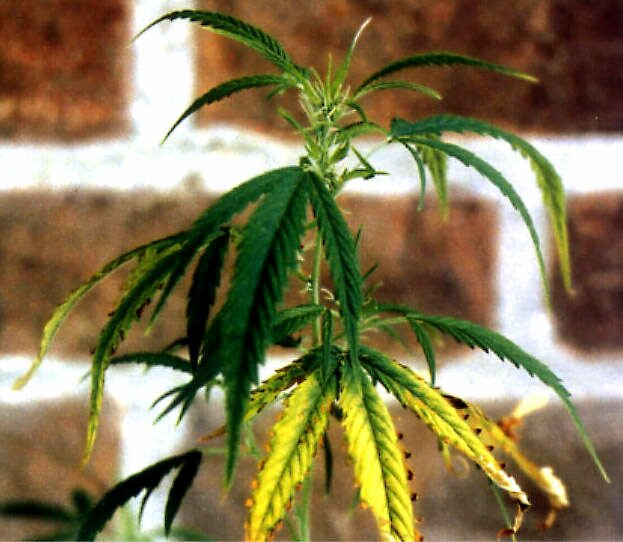
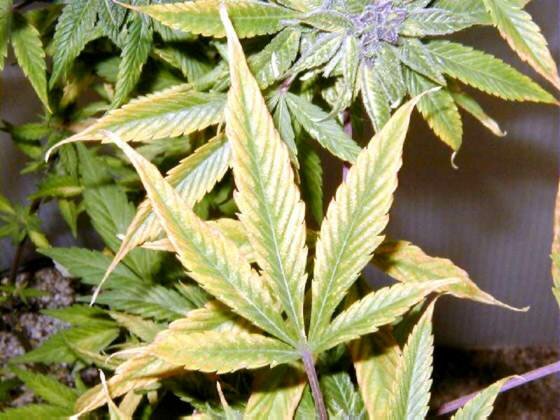
Potassium (K) Toxicity
Usually not absorbed excessively by plants. Excess potassium can aggravate the uptake of magnesium, manganese, zinc and iron and effect the availability of calcium.
Magnesium
Magnesium is a component of the chlorophyll molecule and serves as a cofactor in most enzymes.
Magnesium (Mg) deficiency.
Magnesium deficiency will exhibit a yellowing (which may turn brown) and interveinal chlorosis beginning in the older leaves. The older leaves will be the first to develop interveinal chlorosis. Starting at leaf margin or tip and progressing inward between the veins. Notice how the veins remain somewhat green though as can be seen in figure 15.
Notice how in Figure 16 and 17 the leaves curl upwards like they're praying? They're praying for Mg! The tips may also twist.
This can be quickly resolved by watering with 1 tablespoon Epsom salts/gallon of water. Until you can correct nutrient lockout, try foliar feeding. That way the plants get all the nitrogen and Mg they need. The plants can be foliar feed at ½ teaspoon/quart of Epsom salts (first powdered and dissolved in some hot water). When mixing up soil, use 2 teaspoon dolomite lime per gallon of soil.
If the starting water is above 200 ppm, that is pretty hard water, that will lock out mg with all of the calcium in the water. Either add a 1/4 teaspoon per gallon of epsom salts or lime (both will effectively reduce the lockout or invest into a reverse osmosis water filter.
Mg can get locked-up by too much Ca, Cl or ammonium nitrogen. Don't overdo Mg or you'll lock up other nutrients.
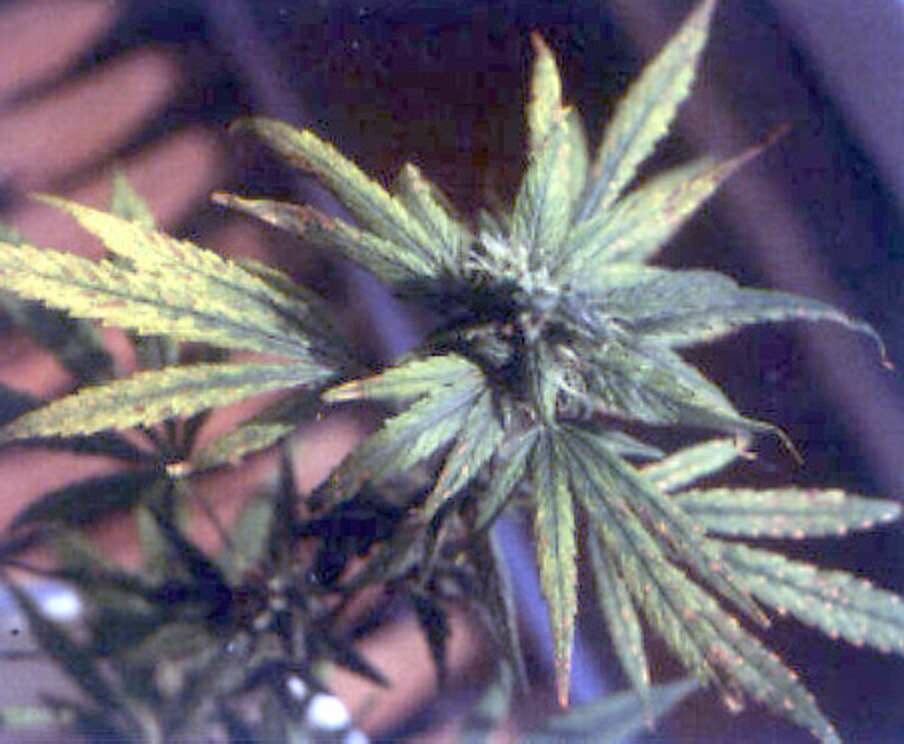
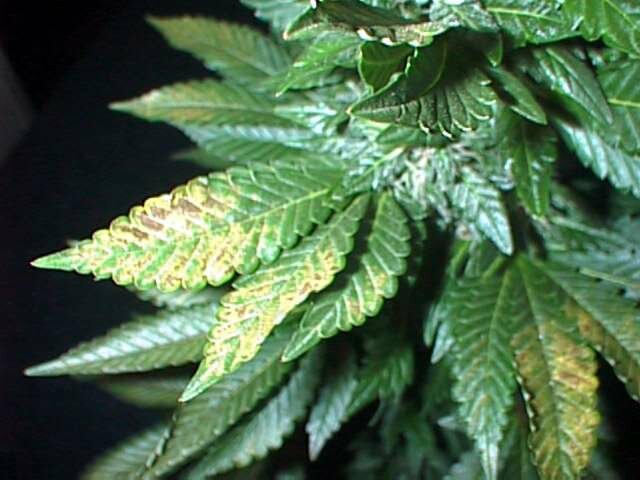
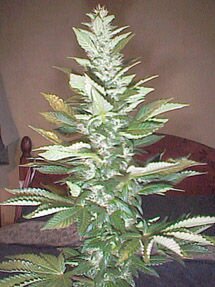
Magnesium (Mg) Toxicity
Magnesium toxicity is rare and not generally exhibited visibly. Extreme high levels will antagonize other ions in the nutrient solution.
Zinc
Zinc plays a roll in the same enzyme functions as manganese and magnesium. More than eighty enzymes contain tightly bound zinc essential for their function. Zinc participates in chlorophyll formation and helps prevent chlorophyll destruction. Carbonic anhydrate has been found to be specifically activated by zinc.
Zinc Deficiencies
Deficiencies appear as chlorosis in the inter-veinal areas of new leaves producing a banding appearance as seen in figure 18. This may be accompany reduction of leaf size and a shortening between internodes. Leaf margins are often distorted or wrinkled. Branch terminals of fruit will die back in severe cases.
Also gets locked out due to high pH. Zn, Fe, and Mn deficiencies often occur together, and are usually from a high pH. Don't overdo the micro-nutrients- lower the pH if that's the problem so the nutrients become available. Foliar feed if the plant looks real bad. Use chelated zinc. Zinc deficiency produces "little leaf" in many species, especially woody ones; the younger leaves are distinctly smaller than normal. Zinc defeciency may also produce "rosetting"; the stem fails to elongate behind the growing tip, so that the terminal leaves become tightly bunched.
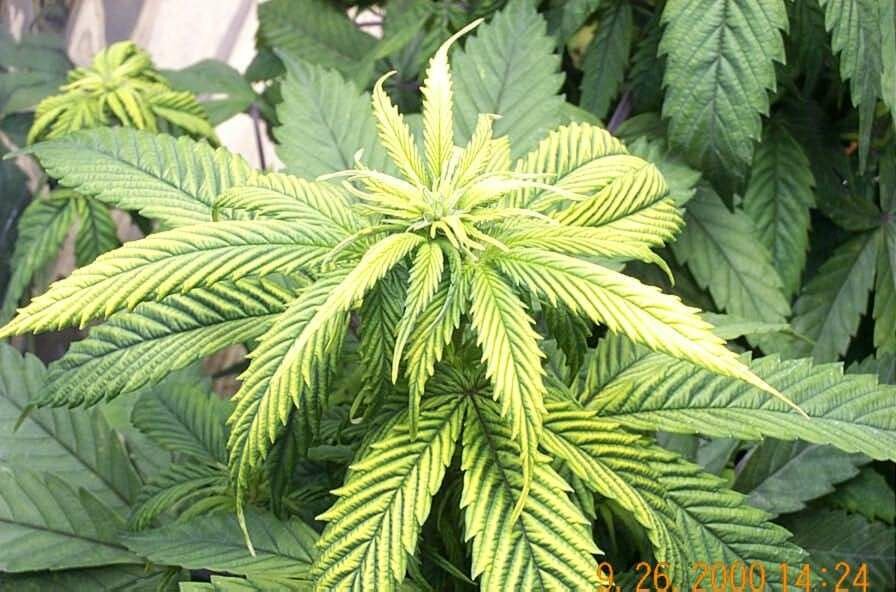
Zinc Toxicity
Excess Zinc is extremely toxic and will cause rapid death. Excess zinc interferes with iron causing chlorosis from iron deficiency. Excess will cause sensitive plants to become chlorotic.
top of page
IMMOBILE ELEMENTS
Immobile elements will show their first symptoms on younger leaves and progress to the whole plant.
Sulphur (S)
Sulfate is involved in protein synthesis and is part of the amino acids, cystine and thiamine, which are the building blocks of proteins. It is active in the structure and metabolism in the plant. It is essential for respiration and the synthesis and breakdown of fatty acids.
Sulphur (S) deficiency
The initial symptoms are the yellowing of the entire leaf including veins usually starting with the younger leaves. Leaf tips may yellow and curl downward. Sulfur deficiencies are light green fruit or younger leaves with a lack of succulence. Elongated roots and woody stem. Although it's hard to see in figure 19, the upper stems of this plant are purple. Although many varieties of cannabis do get purplish stems, the trait generally extends the entire length of the plant's stem, and not just near the top as in this specimen.
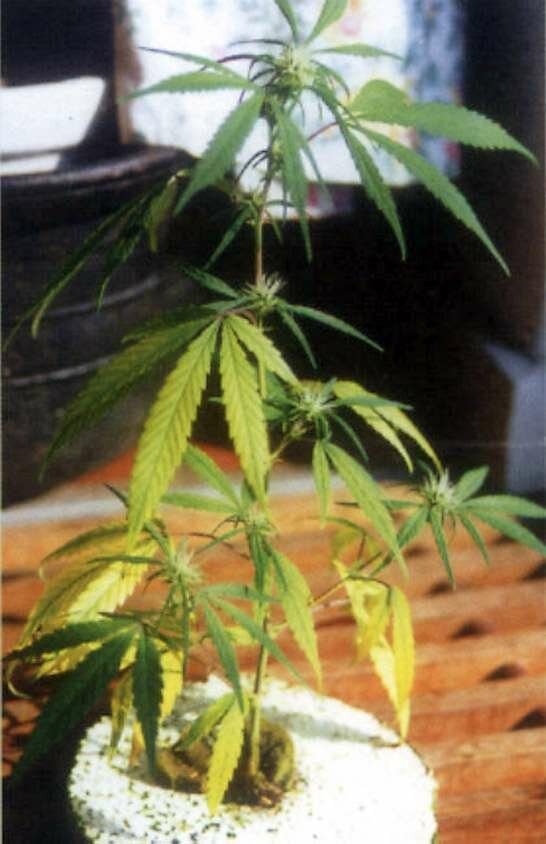
Sulphur Toxicity
Leaf size will be reduced and overall growth will be stunted. Leaves yellowing or scorched at edges. Excess may cause early senescence.
Calcium
Calcium plays an important role in maintaining cell integrity and membrane permeability.
Calcium Deficiency
Young leaves are affected first and become small and distorted or chlorotic with irregular margins, spotting or necrotic areas. Bud development is inhibited, blossom end rot and internal decay may also occur and root may be under developed or die back. Deficiency will cause root tip die-back, leaf tip curl and marginal necrosis and chlorosis primarily in younger leaves. Symptoms: young leaves develop chlorosis and distortion such as crinkling, dwarfing, developing a strap-like shape, shoots stop growing and thicken.
Calcium Toxicity
Difficult to distinguish visually. May precipitate with sulfur in solution and cause clouding or residue in tank. Excess calcium may produce deficiencies in magnesium and potassium.
Iron
Iron is an important component of plant enzyme systems for electron transport to carry electrons during photosynthesis and terminal respiration. It is a catalyst for chlorophyll production and is required for nitrate and sulfate reduction and assimilation.
Iron (Fe) deficiency
Pronounced interveinal chlorosis similar to that caused by magnesium deficiency but on the younger leaves.
Leaves exhibit chlorosis (yellowing) of the leaves mainly between the veins, starting with the lower and middle leaves.
Caused by factors that interfere with iron absorption of roots: over irrigation, excessive soluble salts, inadequate drainage, pests, high substrate pH, or nematodes. This is easily corrected by adding an iron supplement with the next watering.
Fe is unavailable to plants when the pH of the water or soil is too high. If deficient, lower the pH to about 6.5 (for rockwool, about 5.7), and check that you're not adding too much P, which can lock up Fe. Use iron that's chelated for maximum availability. Read your fertilizer's ingredients - chelated iron might read something like "iron EDTA". To much Fe without adding enough P can cause a P-deficiency.
Note that when adding iron to the solution, it is often necessary to not use fertilizer for that watering. Iron has a tendency of reacting with many of the components of fertilizer solutions, and will cause nutrient lockup to occur. Read the labels of both the iron supplement and the fertilizer you are using before you attempt to combine the two.
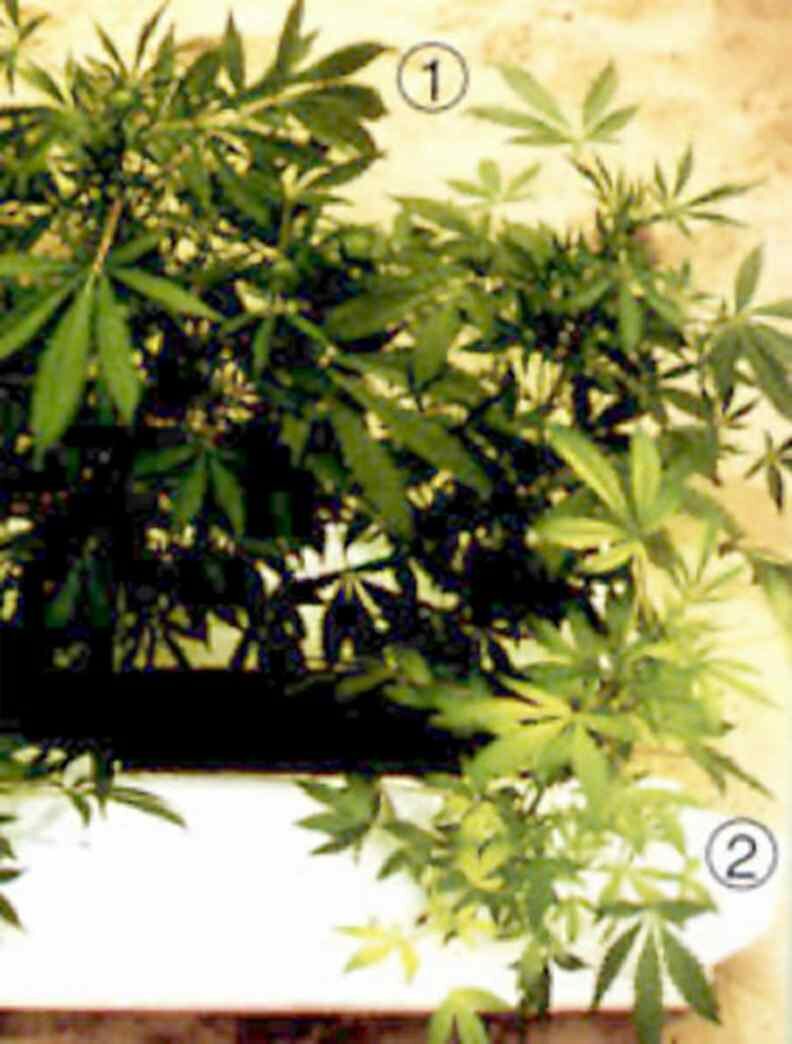
Iron Toxicity
Excess accumulation is rare but could cause bronzing or tiny brown spots on leaf surface.
Manganese
Manganese is involved in the oxidation reduction process in the photosynthetic electron transport system. Biochemical research shows that this element plays a structural role in the chloroplast membrane system, and also activates numerous enzymes.
Manganese Deficiency
Interveinal chlorosis of younger leaves, necrotic lesions and leaf shredding are typical symptom of this deficiency. High levels can cause uneven distribution of chlorophyll resulting in blotchy appearance. Restricted growth and failure to mature normally can also result.
Mn gets locked out when the pH is too high, and when there's too much iron. Use chelated Mn.
Manganese Toxicity
Toxicity:Chlorosis, or blotchy leaf tissue due to insufficient chlorophyll synthesis. Growth rate will slow and vigor will decline.
Chlorine
Chloride is involved in the evolution of oxygen in the photosynthesis process and is essential for cell division in roots and leaves. Chlorine raises the cell osmotic pressure and affects stomata regulation and increases the hydration of plant tissue. Levels less than 140 ppm are safe for most plants. Chloride sensitive plants may experience tip or marginal leaf burn at concentrations above 20 ppm.
Chlorine Deficiency
Wilted chlorotic leaves become bronze in color. Roots become stunted and thickened near tips. Plants with chlorine deficiencies will be pale and suffer wilting.
Chlorine Toxicity
Burning of leaf tip or margins. Bronzing, yellowing and leaf splitting. Reduced leaf size and lower growth rate.
Boron
Boron biochemical functions are yet uncertain, but evidence suggests it is involved in the synthesis of one of the bases for nucleic acid (RNA uracil) formation. It may also be involved in some cellular activities such as division, differentiation, maturation and respiration. It is associated with pollen germination.
Boron Deficiency
Plants deficient in boron exhibit brittle abnormal growth at shoot tips and one of the earliest symptoms is failure of root tips to elongate normally. Stem and root apical meristems often die. Root tips often become swollen and discolored. Internal tissues may rot and become host to fungal disease. Leaves show various symptoms which include drying, thickening, distorting, wilting, and chlorotic or necrotic spotting.
Boron Toxicity
Yellowing of leaf tip followed by necrosis of the leaves beginning at tips or margins and progressing inward before leaves die and prematurely fall off. Some plants are especially sensitive to boron accumulation.
Copper
Copper is a constituent of many enzymes and proteins. Assists in carbohydrate metabolism, nitrogen fixation and in the process of oxygen reduction.
Copper Deficiency
Symptoms of deficiency are a reduced or stunted growth with a distortion of the younger leaves and growth tip die-back. Young leaves often become dark green and twisted. They may die back or just exhibit necrotic spots. Growth and yield will be deficient as well.
Copper Toxicity
Copper is required in very small amounts and readily becomes toxic in solution culture if not carefully controlled. Excess values will induce iron deficiency. Root growth will be suppressed followed by symptoms of iron chlorosis, stunting, reduced branching, abnormal darkening and thickening of roots.
Molybdenum
Molybdenum is a component of two major enzyme systems involved in the nitrate reeducates, this is the process of conversion of nitrate to ammonium.
Molybdenum Deficiencies
Often interveinal chlorosis which occurs first on older leaves, then progressing to the entire plant. Developing severely twisted younger leaves which eventually die. Molybdenum deficiencies frequently resemble nitrogen, with older leaves chlorotic with rolled margins and stunted growth.
Molybdenum Toxicity
Excess may cause discoloration of leaves depending on plant species. This condition is rare but could occur from accumulation by continuous application. Used by the plant in very small quantities. Excess mostly usually does not effect the plant, however the consumption of high levels by grazing animals can pose problems so she might not be too good to smoke.
Sodium
Sodium seems to encourage crop yields and in specific cases it acts as an antidoting agent against various toxic salts. It may act as a partial substitute for potassium deficiencies. Excess may cause plant toxicity or induce deficiencies of other elements. If sodium predominates in the solution calcium and magnesium may be affected.
Silicon
Silicon usually exists in solution as silicic acid and is absorbed in this form. It accumulates as hydrated amorphous silica most abundantly in walls of epidermal cells, but also in primary and secondary walls of other cells. It is largely available in soils and is found in water as well. Inadequate amounts of silicon can reduce tomato yields as much as 50%, cause new leaves to be deformed and inhibit fruit set. At this time toxicity symptoms are undetermined.
Cobalt
Cobalt is essential to many beneficial bacteria that are involved in nitrogen fixation of legumes. It is a component of vitamin B12 which is essential to most animals and possibly in plants. Reports suggest that it may be involved with enzymes needed to form aromatic compounds. Otherwise, it is not understood fully as to its benefit to plant growth, but it is considered essential to some animal health issues.
Marijuana plant abuse disorders, deficiencies, problems with photographs and descriptions.
- Heat Stress
- Nutrient Solution Burn
- Over Watering
- pH Fluctuation
- Ozone Damage
- Nutrient Problems
- Mobile Elements
- Immobile Elements
Look closely, and you'll see the brown leaf edges that are indicative of heat stress. This damage looks alot like nutrient burn, except it occurs only at the tops of the plants closest to the lamps. There's only one cure for this...get the heat away from the plants, either by moving the lamps or moving the plants.

Nutrient Solution Burn
There's a good chance that this bud was subjected to nutrient solution burn. These symptoms are seen when the EC concentration of hydroponic solutions is too high. These symptoms also appear when strong nutrient solution is splashed onto the leaves under hot HID lamps, causing the leaves to burn under the solution.

Many hydroponic gardeners see this problem. It's the beginning of nutriet burn. It indicates that the plants have all the nutrients they can possibly use, and there's a slight excess. Back off the concentration of the nutrient solution just a touch, and the problem should disappear. Note that if the plants never get any worse than this here, then the plants are probably just fine.

Figure 4 is definitely an over-fert problem. The high level of nutrients accumulates in the leaves and causes them to dry out and burn up as shown here. You must flush with clear, clean water immediately to allow the roots to recover, and prevent further damage. The find the cause of the high nutrient levels.

Over Watering
The plants in Figure 1 were on a continous drip system, where nutrient solution is constantly being pumped into the medium. This tends to keep the entire root system completely saturated. A better way would be to periodically feed the plants, say for 1/2 hour every 2-3 hours. This would give the roots a chance to get needed air to them, and prevent root rot and other problems.
Don't be throw off by the fact that the plants in Figure 2 are sitting in still water, this is actually an H2O2 solution used to try and correct the problem. Adding an airstone to the tub would also help add O2 to the solution.

pH Fluctuation
Both of these leaves in figure 3 and figure 4 are from the same plant. It could be over fertilization, but more likely it is due to the pH being off. Too high or too low a pH can lock up nutrients in the form of undisolvable salts and compounds, some of which are actually toxic to the plants. What then happens is the grower then tries to supplement the plants diet by adding more fertilizers, throwing off the pH even more and locking up even more nutrients. This type of problem is seen more often in soil mixes, where inconsistent mixing of the medium's components leads to "hot" spots.


Ozone damage
Ozone damage typically found near the generator. Although a rare problem, symptoms generally appear as a Mg deficiency, but the symptoms are localized to immediately around the generator.

NUTRIENT PROBLEMS
Root stunting
Root stunting is characteristic of calcium deficiency, acidity, aluminum toxicity, and copper toxicity. Some species may also show it when boron deficient. The shortened roots become thickened, the laterals become stubby, peg-like, and the whole system often discolours, brown or grey.
Symptoms localized at shoot growing points.
New shoots unopened; young leaves distorted; dead leaf tips; pale green plant copper deficiency
New shoots withered or dead; petiole or stem collapse; shoots stunted; green plant calcium deficiency
Young leaves pale green or yellow; rosetting or dead tip; dieback; dark green plant boron deficiency
top of page
MOBILE ELEMENTS
Mobile elements are more likely to exhibit visual deficiencies in the older leaves, because during demand these elements will be exported to the new growth.
Nitrogen (N)
Nitrate - Ammonium is found in both inorganic and organic forms in the plant, and combines with carbon, hydrogen, oxygen and sometimes sulfur to form amino acids, amino enzymes, nucleic acids, chlorophyll, alkaloids, and purine bases. Nitrogen rates high as molecular weight proteins in plant tissue.
Plants need lots of N during vegging, but it's easy to overdo it. Added too much? Flush the soil with plain water. Soluble nitrogen (especially nitrate) is the form that's the most quickly available to the roots, while insoluble N (like urea) first needs to be broken down by microbes in the soil before the roots can absorb it. Avoid excessive ammonium nitrogen, which can interfere with other nutrients.
Too much N delays flowering. Plants should be allowed to become N-deficient late in flowering for best flavor.
Nitrogen DeficienciesPlants will exhibit lack of vigor, slow growth and will be weak and stunted. Quality and yield will be significantly reduced. Older leaves become yellow (chlorotic) from lack of chlorophyll. Deficient plants will exhibit uniform light green to yellow on older leaves, these leaves may die and drop. Leaf margins will not curled up noticeably. Chlorosis will eventually spread throughout the plant. Stems, petioles and lower leaf surfaces may turn purple.

As seen in figure 10 consumption of nitrogen (N) from the fan leaves during the final phase of flowing is 100% normal.

Nitrogen Toxicity
Leaves are often dark green and in the early stages abundant with foliage. If excess is severe, leaves will dry and begin to fall off. Root system will remain under developed or deteriorate after time. Fruit and flower set will be inhibited or deformed.
With breakdown of vascular tissue restricting water uptake. Stress resistance is drastically diminished.
Phosphorus
Phosphorus is a component of certain enzymes and proteins, adenosine triphosphate (ATP), ribonucleic acids (RNA), deoxyribonucleic acids (DNA) and phytin. ATP is involved in various energy transfer reactions, and RNA and DNA are components of genetic information.
Phosphorus (P) deficiency
Figure 11 is severe phosphorus (P) deficiency during flowering. Fan leaves are dark green or red/purple, and may turn yellow. Leaves may curl under, go brown and die. Small-formed buds are another main symptom.
Phosphorus deficiencies exhibit slow growing, weak and stunted plants with dark green or purple pigmentation in older leaves and stems.
Some deficiency during flowering is normal, but too much shouldn't be tolerated. Red petioles and stems are a normal, genetic characteristic for many varieties, plus it can also be a co-symptom of N, K, and Mg-deficiencies, so red stems are not a foolproof sign of P-deficiency. Too much P can lead to iron deficiency.
Purpling: accumulation of anthocyanin pigments; causes an overall dark green color with a purple, red, or blue tint, and is the common sign of phosphate deficiency. Some plant species and varieties respond to phosphate deficiency by yellowing instead of purpling. Purpling is natural to some healthy ornamentals.

Figure 12 shows Phosphorus (P) deficiency during vegatative growth. Many people mistaken this for a fungus, but look for the damage to occur near the end of leave, and leaves the color dull greyish with a very brittle texture.

Phosphorus (P) Toxicity
This condition is rare and usually buffered by pH limitations. Excess phosphorus can interfere with the availability and stability of copper and zinc.
Potassium (K)
Potassium is involved in maintaining the water status of the plant and the tugor pressure of it's cells and the opening and closing of the stomata. Potassium is required in the accumulation and translocation of carbohydrates. Lack of potassium will reduce yield and quality.
Potassium deficiency (K).
Older leaves are initially chlorotic but soon develop dark necrotic lesions (dead tissue). First apparent on the tips and margins of the leaves. Stem and branches may become weak and easily broken, the plant may also stretch. The plant will become susceptible to disease and toxicity. In addition to appearing to look like iron deficiency, the tips of the leaves curl and the edges burn and die.
Potassium - Too much sodium (Na) displaces K, causing a K deficiency. Sources of high salinity are: baking soda (sodium bicarbonate "pH-up"), too much manure, and the use of water-softening filters (which should not be used). If the problem is Na, flush the soil. K can get locked up from too much Ca or ammonium nitrogen, and possibly cold weather.


Potassium (K) Toxicity
Usually not absorbed excessively by plants. Excess potassium can aggravate the uptake of magnesium, manganese, zinc and iron and effect the availability of calcium.
Magnesium
Magnesium is a component of the chlorophyll molecule and serves as a cofactor in most enzymes.
Magnesium (Mg) deficiency.
Magnesium deficiency will exhibit a yellowing (which may turn brown) and interveinal chlorosis beginning in the older leaves. The older leaves will be the first to develop interveinal chlorosis. Starting at leaf margin or tip and progressing inward between the veins. Notice how the veins remain somewhat green though as can be seen in figure 15.
Notice how in Figure 16 and 17 the leaves curl upwards like they're praying? They're praying for Mg! The tips may also twist.
This can be quickly resolved by watering with 1 tablespoon Epsom salts/gallon of water. Until you can correct nutrient lockout, try foliar feeding. That way the plants get all the nitrogen and Mg they need. The plants can be foliar feed at ½ teaspoon/quart of Epsom salts (first powdered and dissolved in some hot water). When mixing up soil, use 2 teaspoon dolomite lime per gallon of soil.
If the starting water is above 200 ppm, that is pretty hard water, that will lock out mg with all of the calcium in the water. Either add a 1/4 teaspoon per gallon of epsom salts or lime (both will effectively reduce the lockout or invest into a reverse osmosis water filter.
Mg can get locked-up by too much Ca, Cl or ammonium nitrogen. Don't overdo Mg or you'll lock up other nutrients.



Magnesium (Mg) Toxicity
Magnesium toxicity is rare and not generally exhibited visibly. Extreme high levels will antagonize other ions in the nutrient solution.
Zinc
Zinc plays a roll in the same enzyme functions as manganese and magnesium. More than eighty enzymes contain tightly bound zinc essential for their function. Zinc participates in chlorophyll formation and helps prevent chlorophyll destruction. Carbonic anhydrate has been found to be specifically activated by zinc.
Zinc Deficiencies
Deficiencies appear as chlorosis in the inter-veinal areas of new leaves producing a banding appearance as seen in figure 18. This may be accompany reduction of leaf size and a shortening between internodes. Leaf margins are often distorted or wrinkled. Branch terminals of fruit will die back in severe cases.
Also gets locked out due to high pH. Zn, Fe, and Mn deficiencies often occur together, and are usually from a high pH. Don't overdo the micro-nutrients- lower the pH if that's the problem so the nutrients become available. Foliar feed if the plant looks real bad. Use chelated zinc. Zinc deficiency produces "little leaf" in many species, especially woody ones; the younger leaves are distinctly smaller than normal. Zinc defeciency may also produce "rosetting"; the stem fails to elongate behind the growing tip, so that the terminal leaves become tightly bunched.

Zinc Toxicity
Excess Zinc is extremely toxic and will cause rapid death. Excess zinc interferes with iron causing chlorosis from iron deficiency. Excess will cause sensitive plants to become chlorotic.
top of page
IMMOBILE ELEMENTS
Immobile elements will show their first symptoms on younger leaves and progress to the whole plant.
Sulphur (S)
Sulfate is involved in protein synthesis and is part of the amino acids, cystine and thiamine, which are the building blocks of proteins. It is active in the structure and metabolism in the plant. It is essential for respiration and the synthesis and breakdown of fatty acids.
Sulphur (S) deficiency
The initial symptoms are the yellowing of the entire leaf including veins usually starting with the younger leaves. Leaf tips may yellow and curl downward. Sulfur deficiencies are light green fruit or younger leaves with a lack of succulence. Elongated roots and woody stem. Although it's hard to see in figure 19, the upper stems of this plant are purple. Although many varieties of cannabis do get purplish stems, the trait generally extends the entire length of the plant's stem, and not just near the top as in this specimen.

Sulphur Toxicity
Leaf size will be reduced and overall growth will be stunted. Leaves yellowing or scorched at edges. Excess may cause early senescence.
Calcium
Calcium plays an important role in maintaining cell integrity and membrane permeability.
Calcium Deficiency
Young leaves are affected first and become small and distorted or chlorotic with irregular margins, spotting or necrotic areas. Bud development is inhibited, blossom end rot and internal decay may also occur and root may be under developed or die back. Deficiency will cause root tip die-back, leaf tip curl and marginal necrosis and chlorosis primarily in younger leaves. Symptoms: young leaves develop chlorosis and distortion such as crinkling, dwarfing, developing a strap-like shape, shoots stop growing and thicken.
Calcium Toxicity
Difficult to distinguish visually. May precipitate with sulfur in solution and cause clouding or residue in tank. Excess calcium may produce deficiencies in magnesium and potassium.
Iron
Iron is an important component of plant enzyme systems for electron transport to carry electrons during photosynthesis and terminal respiration. It is a catalyst for chlorophyll production and is required for nitrate and sulfate reduction and assimilation.
Iron (Fe) deficiency
Pronounced interveinal chlorosis similar to that caused by magnesium deficiency but on the younger leaves.
Leaves exhibit chlorosis (yellowing) of the leaves mainly between the veins, starting with the lower and middle leaves.
Caused by factors that interfere with iron absorption of roots: over irrigation, excessive soluble salts, inadequate drainage, pests, high substrate pH, or nematodes. This is easily corrected by adding an iron supplement with the next watering.
Fe is unavailable to plants when the pH of the water or soil is too high. If deficient, lower the pH to about 6.5 (for rockwool, about 5.7), and check that you're not adding too much P, which can lock up Fe. Use iron that's chelated for maximum availability. Read your fertilizer's ingredients - chelated iron might read something like "iron EDTA". To much Fe without adding enough P can cause a P-deficiency.
Note that when adding iron to the solution, it is often necessary to not use fertilizer for that watering. Iron has a tendency of reacting with many of the components of fertilizer solutions, and will cause nutrient lockup to occur. Read the labels of both the iron supplement and the fertilizer you are using before you attempt to combine the two.

Iron Toxicity
Excess accumulation is rare but could cause bronzing or tiny brown spots on leaf surface.
Manganese
Manganese is involved in the oxidation reduction process in the photosynthetic electron transport system. Biochemical research shows that this element plays a structural role in the chloroplast membrane system, and also activates numerous enzymes.
Manganese Deficiency
Interveinal chlorosis of younger leaves, necrotic lesions and leaf shredding are typical symptom of this deficiency. High levels can cause uneven distribution of chlorophyll resulting in blotchy appearance. Restricted growth and failure to mature normally can also result.
Mn gets locked out when the pH is too high, and when there's too much iron. Use chelated Mn.
Manganese Toxicity
Toxicity:Chlorosis, or blotchy leaf tissue due to insufficient chlorophyll synthesis. Growth rate will slow and vigor will decline.
Chlorine
Chloride is involved in the evolution of oxygen in the photosynthesis process and is essential for cell division in roots and leaves. Chlorine raises the cell osmotic pressure and affects stomata regulation and increases the hydration of plant tissue. Levels less than 140 ppm are safe for most plants. Chloride sensitive plants may experience tip or marginal leaf burn at concentrations above 20 ppm.
Chlorine Deficiency
Wilted chlorotic leaves become bronze in color. Roots become stunted and thickened near tips. Plants with chlorine deficiencies will be pale and suffer wilting.
Chlorine Toxicity
Burning of leaf tip or margins. Bronzing, yellowing and leaf splitting. Reduced leaf size and lower growth rate.
Boron
Boron biochemical functions are yet uncertain, but evidence suggests it is involved in the synthesis of one of the bases for nucleic acid (RNA uracil) formation. It may also be involved in some cellular activities such as division, differentiation, maturation and respiration. It is associated with pollen germination.
Boron Deficiency
Plants deficient in boron exhibit brittle abnormal growth at shoot tips and one of the earliest symptoms is failure of root tips to elongate normally. Stem and root apical meristems often die. Root tips often become swollen and discolored. Internal tissues may rot and become host to fungal disease. Leaves show various symptoms which include drying, thickening, distorting, wilting, and chlorotic or necrotic spotting.
Boron Toxicity
Yellowing of leaf tip followed by necrosis of the leaves beginning at tips or margins and progressing inward before leaves die and prematurely fall off. Some plants are especially sensitive to boron accumulation.
Copper
Copper is a constituent of many enzymes and proteins. Assists in carbohydrate metabolism, nitrogen fixation and in the process of oxygen reduction.
Copper Deficiency
Symptoms of deficiency are a reduced or stunted growth with a distortion of the younger leaves and growth tip die-back. Young leaves often become dark green and twisted. They may die back or just exhibit necrotic spots. Growth and yield will be deficient as well.
Copper Toxicity
Copper is required in very small amounts and readily becomes toxic in solution culture if not carefully controlled. Excess values will induce iron deficiency. Root growth will be suppressed followed by symptoms of iron chlorosis, stunting, reduced branching, abnormal darkening and thickening of roots.
Molybdenum
Molybdenum is a component of two major enzyme systems involved in the nitrate reeducates, this is the process of conversion of nitrate to ammonium.
Molybdenum Deficiencies
Often interveinal chlorosis which occurs first on older leaves, then progressing to the entire plant. Developing severely twisted younger leaves which eventually die. Molybdenum deficiencies frequently resemble nitrogen, with older leaves chlorotic with rolled margins and stunted growth.
Molybdenum Toxicity
Excess may cause discoloration of leaves depending on plant species. This condition is rare but could occur from accumulation by continuous application. Used by the plant in very small quantities. Excess mostly usually does not effect the plant, however the consumption of high levels by grazing animals can pose problems so she might not be too good to smoke.
Sodium
Sodium seems to encourage crop yields and in specific cases it acts as an antidoting agent against various toxic salts. It may act as a partial substitute for potassium deficiencies. Excess may cause plant toxicity or induce deficiencies of other elements. If sodium predominates in the solution calcium and magnesium may be affected.
Silicon
Silicon usually exists in solution as silicic acid and is absorbed in this form. It accumulates as hydrated amorphous silica most abundantly in walls of epidermal cells, but also in primary and secondary walls of other cells. It is largely available in soils and is found in water as well. Inadequate amounts of silicon can reduce tomato yields as much as 50%, cause new leaves to be deformed and inhibit fruit set. At this time toxicity symptoms are undetermined.
Cobalt
Cobalt is essential to many beneficial bacteria that are involved in nitrogen fixation of legumes. It is a component of vitamin B12 which is essential to most animals and possibly in plants. Reports suggest that it may be involved with enzymes needed to form aromatic compounds. Otherwise, it is not understood fully as to its benefit to plant growth, but it is considered essential to some animal health issues.

